Latest News
Ready or Not, Manufacturers will Soon be Held to Rigid Sustainability Standards
AMGTA Shares Findings on Sustainability of Powder and Wire Additive Feedstock
MATLABS Features Modelithics EXEMPLAR Library
Fictiv Demonstrates New AI Capabilities
ADDMAN Earns Qualification Project for U.S. Navy
FREE WEBINAR May 7: Addressing the Skilled Worker Shortage with Customized eLearning
All posts
July 11, 2007
By Anthony J. Lockwood
MSC.Software Corp. (Santa Ana, CA) has announced the 2007 r1 release of its core CAE products, Adams, MSC Nastran, Patran, Marc, and Dytran. The company says that the newest release expands simulation capabilities, increases solution performance, and improves the overall productivity of the virtual product development process.
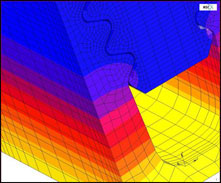 MSC Nastran 2007 r1 focuses on new features and improvements particularly in such areas of concern as numerical analysis and high-performance computing (HPC) for solving large systems, dynamics and NVH simulations, implicit nonlinear analysis, assembly modeling, design optimization, rotor dynamics, and aeroelasticity. It offers two new sparse solvers — TAUCS (statics) and UMFPACK (unsymmetric) — automated procedures for thermal stress analysis, new seam-weld (CSEAM) connector element for assembly modeling, and the ability to combine topology, sizing, and shape optimization simultaneously. MSC Nastran 2007 r1 also now supports Microsoft Compute Cluster and Compute kernels for 64-bit x86 platforms optimized for Intel and AMD systems. Click here for more on MSC Nastran 2007 r1.
MSC Nastran 2007 r1 focuses on new features and improvements particularly in such areas of concern as numerical analysis and high-performance computing (HPC) for solving large systems, dynamics and NVH simulations, implicit nonlinear analysis, assembly modeling, design optimization, rotor dynamics, and aeroelasticity. It offers two new sparse solvers — TAUCS (statics) and UMFPACK (unsymmetric) — automated procedures for thermal stress analysis, new seam-weld (CSEAM) connector element for assembly modeling, and the ability to combine topology, sizing, and shape optimization simultaneously. MSC Nastran 2007 r1 also now supports Microsoft Compute Cluster and Compute kernels for 64-bit x86 platforms optimized for Intel and AMD systems. Click here for more on MSC Nastran 2007 r1.
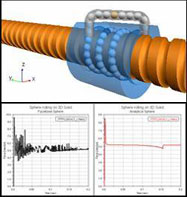 The 2007 r1 releases of MSC.Software’s Adams Solver, Adams/Vibration, and Adams/Car have been enhanced with analytical spheres in 3D contact, run-time aggregate mass calculation, and plot stress and strain nodal results for Flex-Body in FRF simulations. Documentation has also been improved. Click here for more on Adams 2007 r1.
The 2007 r1 releases of MSC.Software’s Adams Solver, Adams/Vibration, and Adams/Car have been enhanced with analytical spheres in 3D contact, run-time aggregate mass calculation, and plot stress and strain nodal results for Flex-Body in FRF simulations. Documentation has also been improved. Click here for more on Adams 2007 r1.
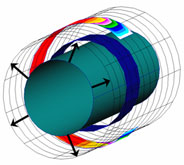 The Patran pre- and postprocessor now offers support for 64-bit hardware, a new bolt-modeling tool, and the ability to control dynamic model manipulations. Its user interface has been extended with new right-clickable context-sensitive menus. Click here for complete details on Patran.
The Patran pre- and postprocessor now offers support for 64-bit hardware, a new bolt-modeling tool, and the ability to control dynamic model manipulations. Its user interface has been extended with new right-clickable context-sensitive menus. Click here for complete details on Patran.
The new release of Marc offers many enhancements, including new optimizations for handling large assemblies such as powertrain systems. It has new capabilities for component failure and delamination, and improvements in structural and thermal modeling. Marc provides new element and material models, including interface elements, cohesive material models, and MSC Nastran (NLELAST) capability to model nonlinear stress-strain curves; and additional composites failure criteria including Hashin and Puck. Marc’s new Cohesive Zone Modeling for delamination provides a methodology for simulating the physical separation of different materials or crack growth in a single material. Click here for details on Marc 2007 r1.
 MSC Nastran 2007 r1 focuses on new features and improvements particularly in such areas of concern as numerical analysis and high-performance computing (HPC) for solving large systems, dynamics and NVH simulations, implicit nonlinear analysis, assembly modeling, design optimization, rotor dynamics, and aeroelasticity. It offers two new sparse solvers — TAUCS (statics) and UMFPACK (unsymmetric) — automated procedures for thermal stress analysis, new seam-weld (CSEAM) connector element for assembly modeling, and the ability to combine topology, sizing, and shape optimization simultaneously. MSC Nastran 2007 r1 also now supports Microsoft Compute Cluster and Compute kernels for 64-bit x86 platforms optimized for Intel and AMD systems. Click here for more on MSC Nastran 2007 r1.
MSC Nastran 2007 r1 focuses on new features and improvements particularly in such areas of concern as numerical analysis and high-performance computing (HPC) for solving large systems, dynamics and NVH simulations, implicit nonlinear analysis, assembly modeling, design optimization, rotor dynamics, and aeroelasticity. It offers two new sparse solvers — TAUCS (statics) and UMFPACK (unsymmetric) — automated procedures for thermal stress analysis, new seam-weld (CSEAM) connector element for assembly modeling, and the ability to combine topology, sizing, and shape optimization simultaneously. MSC Nastran 2007 r1 also now supports Microsoft Compute Cluster and Compute kernels for 64-bit x86 platforms optimized for Intel and AMD systems. Click here for more on MSC Nastran 2007 r1. The 2007 r1 releases of MSC.Software’s Adams Solver, Adams/Vibration, and Adams/Car have been enhanced with analytical spheres in 3D contact, run-time aggregate mass calculation, and plot stress and strain nodal results for Flex-Body in FRF simulations. Documentation has also been improved. Click here for more on Adams 2007 r1.
The 2007 r1 releases of MSC.Software’s Adams Solver, Adams/Vibration, and Adams/Car have been enhanced with analytical spheres in 3D contact, run-time aggregate mass calculation, and plot stress and strain nodal results for Flex-Body in FRF simulations. Documentation has also been improved. Click here for more on Adams 2007 r1. The Patran pre- and postprocessor now offers support for 64-bit hardware, a new bolt-modeling tool, and the ability to control dynamic model manipulations. Its user interface has been extended with new right-clickable context-sensitive menus. Click here for complete details on Patran.
The Patran pre- and postprocessor now offers support for 64-bit hardware, a new bolt-modeling tool, and the ability to control dynamic model manipulations. Its user interface has been extended with new right-clickable context-sensitive menus. Click here for complete details on Patran.The new release of Marc offers many enhancements, including new optimizations for handling large assemblies such as powertrain systems. It has new capabilities for component failure and delamination, and improvements in structural and thermal modeling. Marc provides new element and material models, including interface elements, cohesive material models, and MSC Nastran (NLELAST) capability to model nonlinear stress-strain curves; and additional composites failure criteria including Hashin and Puck. Marc’s new Cohesive Zone Modeling for delamination provides a methodology for simulating the physical separation of different materials or crack growth in a single material. Click here for details on Marc 2007 r1.
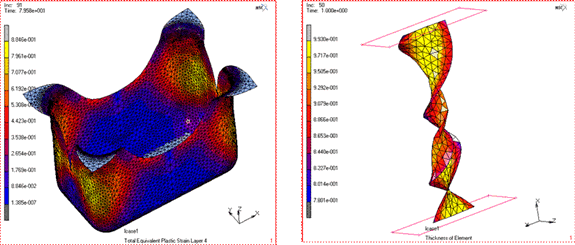
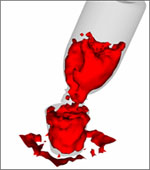 MSC.Software says that this release of Dytran offers new capabilities intended to reduce solution time for many fluid-structural interaction problems. For example, it offers graded meshes for Euler elements as well as the ability to allow for non-uniform Euler meshing. It offers speedier performance for stationary coupling surfaces and axisymmetric mesh models. Enhanced functionality for naval shipping and UNDEX applications has also been added in this release. Miscellaneous features include a new capability to model the gauge pressure in a pressurized bottle and the ability to model prestressed concrete structures. Click here to go to the Dytran 2007 r1 web page.
MSC.Software says that this release of Dytran offers new capabilities intended to reduce solution time for many fluid-structural interaction problems. For example, it offers graded meshes for Euler elements as well as the ability to allow for non-uniform Euler meshing. It offers speedier performance for stationary coupling surfaces and axisymmetric mesh models. Enhanced functionality for naval shipping and UNDEX applications has also been added in this release. Miscellaneous features include a new capability to model the gauge pressure in a pressurized bottle and the ability to model prestressed concrete structures. Click here to go to the Dytran 2007 r1 web page.MSC.Software says that the 2007 r1 releases of Adams, MSC Nastran, Patran, Marc, and Dytran are available immediately. For complete details, go to MSC.Software.
Subscribe to our FREE magazine, FREE email newsletters or both!
Join over 90,000 engineering professionals who get fresh engineering news as soon as it is published.
Latest News
Ready or Not, Manufacturers will Soon be Held to Rigid Sustainability Standards
AMGTA Shares Findings on Sustainability of Powder and Wire Additive Feedstock
MATLABS Features Modelithics EXEMPLAR Library
Fictiv Demonstrates New AI Capabilities
ADDMAN Earns Qualification Project for U.S. Navy
FREE WEBINAR May 7: Addressing the Skilled Worker Shortage with Customized eLearning
All posts
About the Author
Anthony J. Lockwood is Digital Engineering’s founding editor. He is now retired. Contact him via [email protected].
Follow DE#9669
New & Noteworthy

New & Noteworthy: Safe, Cost-Effective Metal 3D Printing - Anywhere
Desktop Metal’s Studio System offers turnkey metal printing for prototypes and...

New & Noteworthy: Direct Neutronics Analysis on CAD
Coreform Cubit 2023.11 workflows enable neutronics directly on CAD for next-generation nuclear energy...

New & Noteworthy: Agile Engineering Collaboration
Authentise Threads is a new software tool for distributed communications and project...

New & Noteworthy Product Introduction: Enterprise VR Headset
Lenovo ThinkReality VRX has an immersive display works with virtual, augmented and...


